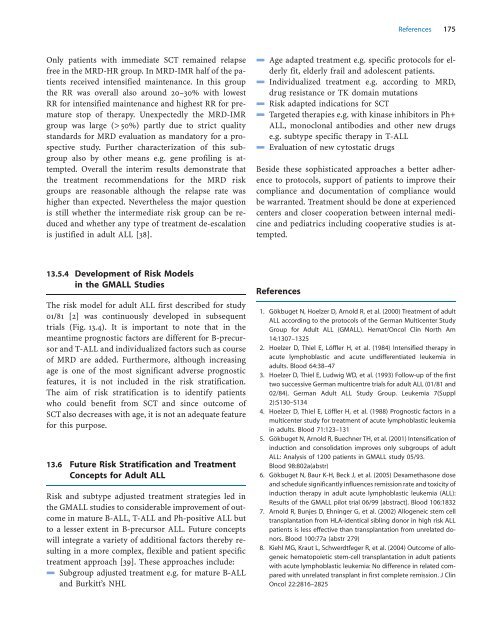Acute Leukemias - Republican Scientific Medical Library
Acute Leukemias - Republican Scientific Medical Library
Acute Leukemias - Republican Scientific Medical Library
Create successful ePaper yourself
Turn your PDF publications into a flip-book with our unique Google optimized e-Paper software.
a References 175<br />
Only patients with immediate SCT remained relapse<br />
free in the MRD-HR group. In MRD-IMR half of the patients<br />
received intensified maintenance. In this group<br />
the RR was overall also around 20–30% with lowest<br />
RR for intensified maintenance and highest RR for premature<br />
stop of therapy. Unexpectedly the MRD-IMR<br />
group was large (> 50%) partly due to strict quality<br />
standards for MRD evaluation as mandatory for a prospective<br />
study. Further characterization of this subgroup<br />
also by other means e.g. gene profiling is attempted.<br />
Overall the interim results demonstrate that<br />
the treatment recommendations for the MRD risk<br />
groups are reasonable although the relapse rate was<br />
higher than expected. Nevertheless the major question<br />
is still whether the intermediate risk group can be reduced<br />
and whether any type of treatment de-escalation<br />
is justified in adult ALL [38].<br />
13.5.4 Development of Risk Models<br />
in the GMALL Studies<br />
The risk model for adult ALL first described for study<br />
01/81 [2] was continuously developed in subsequent<br />
trials (Fig. 13.4). It is important to note that in the<br />
meantime prognostic factors are different for B-precursor<br />
and T-ALL and individualized factors such as course<br />
of MRD are added. Furthermore, although increasing<br />
age is one of the most significant adverse prognostic<br />
features, it is not included in the risk stratification.<br />
The aim of risk stratification is to identify patients<br />
who could benefit from SCT and since outcome of<br />
SCT also decreases with age, it is not an adequate feature<br />
for this purpose.<br />
13.6 Future Risk Stratification and Treatment<br />
Concepts for Adult ALL<br />
Risk and subtype adjusted treatment strategies led in<br />
the GMALL studies to considerable improvement of outcome<br />
in mature B-ALL, T-ALL and Ph-positive ALL but<br />
to a lesser extent in B-precursor ALL. Future concepts<br />
will integrate a variety of additional factors thereby resulting<br />
in a more complex, flexible and patient specific<br />
treatment approach [39]. These approaches include:<br />
4 Subgroup adjusted treatment e.g. for mature B-ALL<br />
and Burkitt’s NHL<br />
4 Age adapted treatment e.g. specific protocols for elderly<br />
fit, elderly frail and adolescent patients.<br />
4 Individualized treatment e.g. according to MRD,<br />
drug resistance or TK domain mutations<br />
4 Risk adapted indications for SCT<br />
4 Targeted therapies e.g. with kinase inhibitors in Ph+<br />
ALL, monoclonal antibodies and other new drugs<br />
e.g. subtype specific therapy in T-ALL<br />
4 Evaluation of new cytostatic drugs<br />
Beside these sophisticated approaches a better adherence<br />
to protocols, support of patients to improve their<br />
compliance and documentation of compliance would<br />
be warranted. Treatment should be done at experienced<br />
centers and closer cooperation between internal medicine<br />
and pediatrics including cooperative studies is attempted.<br />
References<br />
1. Gökbuget N, Hoelzer D, Arnold R, et al. (2000) Treatment of adult<br />
ALL according to the protocols of the German Multicenter Study<br />
Group for Adult ALL (GMALL). Hemat/Oncol Clin North Am<br />
14:1307–1325<br />
2. Hoelzer D, Thiel E, Löffler H, et al. (1984) Intensified therapy in<br />
acute lymphoblastic and acute undifferentiated leukemia in<br />
adults. Blood 64:38–47<br />
3. Hoelzer D, Thiel E, Ludwig WD, et al. (1993) Follow-up of the first<br />
two successive German multicentre trials for adult ALL (01/81 and<br />
02/84). German Adult ALL Study Group. Leukemia 7(Suppl<br />
2):S130–S134<br />
4. Hoelzer D, Thiel E, Löffler H, et al. (1988) Prognostic factors in a<br />
multicenter study for treatment of acute lymphoblastic leukemia<br />
in adults. Blood 71:123–131<br />
5. Gökbuget N, Arnold R, Buechner TH, et al. (2001) Intensification of<br />
induction and consolidation improves only subgroups of adult<br />
ALL: Analysis of 1200 patients in GMALL study 05/93.<br />
Blood 98:802a(abstr)<br />
6. Gökbuget N, Baur K-H, Beck J, et al. (2005) Dexamethasone dose<br />
and schedule significantly influences remission rate and toxicity of<br />
induction therapy in adult acute lymphoblastic leukemia (ALL):<br />
Results of the GMALL pilot trial 06/99 [abstract]. Blood 106:1832<br />
7. Arnold R, Bunjes D, Ehninger G, et al. (2002) Allogeneic stem cell<br />
transplantation from HLA-identical sibling donor in high risk ALL<br />
patients is less effective than transplantation from unrelated donors.<br />
Blood 100:77a (abstr 279)<br />
8. Kiehl MG, Kraut L, Schwerdtfeger R, et al. (2004) Outcome of allogeneic<br />
hematopoietic stem-cell transplantation in adult patients<br />
with acute lymphoblastic leukemia: No difference in related compared<br />
with unrelated transplant in first complete remission. J Clin<br />
Oncol 22:2816–2825
















